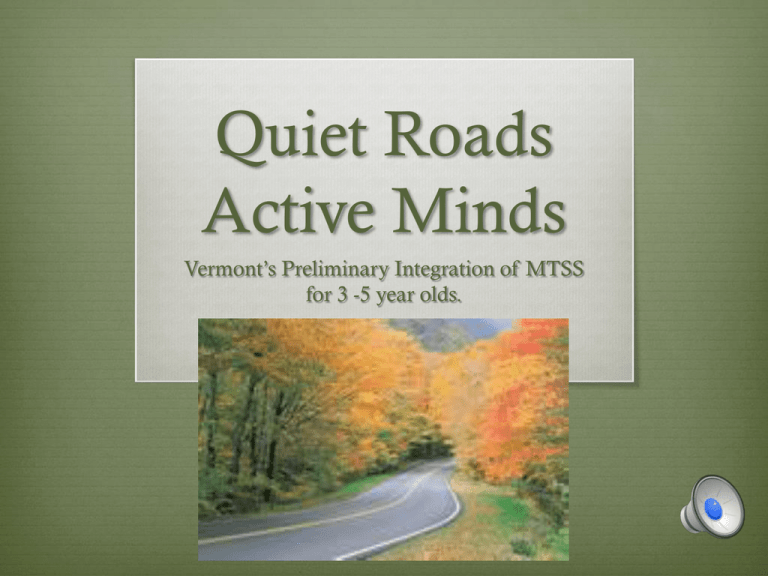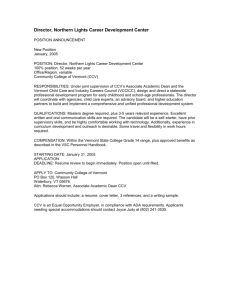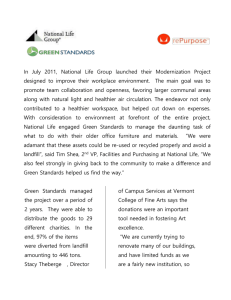(Vermont DOE) Support
advertisement

Quiet Roads Active Minds Vermont’s Preliminary Integration of MTSS for 3 -5 year olds. Vermont’s Demographics Population estimate 2011 – 626,431 Persons under 5 years of age – 5.0% High school graduates, percentage of persons 25+ 2006 -2010 – 90.6% Homeownership rate 2006 – 2010 – 71.4% Per capita money income in past 12 months (2010 dollars) – 2006 -2010 $27,478 Child population 2008 – 2010 – 20.9% Children in poverty 2008 -2010 – 18,550 Students enrolled in free and reduced lunch price school meals program 2011 – 2012 – 40.7% Children benefiting from Dr. Dynosaur and Medicaid 2008 – 2010 – 43.9% Statewide Initiative to build Tier I capacity To ensure a high quality universal environment in early care and education settings two national models are being implemented: • Pyramid Model for promoting social-emotional competence of young children (CSEFEL) • Use of evidence –based practices to support early language and literacy learning of young children (CELL) The Beginning… *In 2008 Vermont received TA grants from CSEFEL and CELL allowing for a state model – Foundations for Early Learning (FEL) to be created. • Additional funding from SPDG, 619 (IDEA), and Early Intervention (PartC) • Train the trainer model has produced trainers and coaches who become FEL champions throughout the state • The effectiveness of this model has been recognized by the VT Department of Education Leadership Team who has supported it’s continuation Few children Children at-risk All Children Not Milking – Sugaring the System Vermont’s initiatives at each level of the pyramid focus on the implementation of scientifically research based practices that work for young children. Awareness of these practices informs initiatives statewide. Pyramid Framework is inclusive of other state initiatives.. Intervention EEE, CIS: EI/EC, FMH, EST Prevention CIS: Nursing and Family services/ EI/ECFMH, Nurse Family Partnership, Head Start Universal Promotion DAP, Touchpoints, Second Step, IMIL, Building Blocks for Literacy Road to Sustainability Vermont’s state plan across programs and communities ‘The Road to Sustainability’ (across Programs and Communities) and Implementation Fidelity Phase 1 Implementation • Statewide TOT • Demo Sites identified across state Phase 2 Full operation and Innovation Phase 3 Sustained System-wide Practice • Capacity building and scaling up • Quality control • Use of data for evidenced based decision making • Statewide adoption of FEL • Ongoing targeted evaluation • Continued support of TA providers • Incorporation of new initiatives into quality programs North Country Supervisory Union Demographics North Country Supervisory Union /Northeast Kingdom: · Largest geographic area for a district; sixty miles west to east · 32 people per square mile compared to 68 for the state average · 53% free and reduced lunch compared to VT state’s 40.7% · 80% Medicaid eligible compared to VT state’s 43% · Highest unemployment rate for Vermont at 9.8% averaging 2 % higher than the state · WWW.NVDA-StrategicIndustries_Report_June_2011 ; http://datacenter.kidscount.org About 50% of three to five year olds receive no formal preschool education North Country Supervisory Union Vermont’s Public Preschool MTSS Pilot Site 7 miles 6 miles 8 miles 6 miles 7 miles 8 miles NCSU ECP (West Side) Creative Minds Daycare NCSU ECP (Newport) Newport Head Start (partner) Holland School (ADM) NCSU ECP/Derby ADM (Derby) Brighton Head Start 25 miles Derby Head Start 15 miles Charleston School (ADM) Brighton School (ADM) Focusing on both sides of the coin Multi-Tiered Approach Systems development Implementation of Practice Progress and Sustainability Creating systems and functional practices MTSS (RTI) Support Mapping System Implementation of Instruction Who will provide small group instruction? Duration / frequency? Domain specific sessions? What screening and assessment tools to assess Tier I & Tier II ? Pilot Site Sustainability State (Vermont DOE) Support § Funding through the SPDG District support · District-wide goals· Capacity building with coaches · Designated “data days” Role of retired teachers Administrative support · Scheduling · Prioritizing current funding streams and exploring new sources Commitment to partnership Committing resources Vermont’s vision for continued progress Continue to build statewide capacity to provide ongoing support for the universal tier As pilot sites demonstrate fidelity at the universal level support a multi-tiered system of supports that includes screening and instruction at tiers two and three Focus on ensuring that all initiatives fit in the pyramid model Develop a common vocabulary and articulation of MTSS systems in order to ensure successful transitions to kindergarten Bridges to Success “Coming together is a beginning. Keeping together is progress. Working together is success. ” Henry Ford











